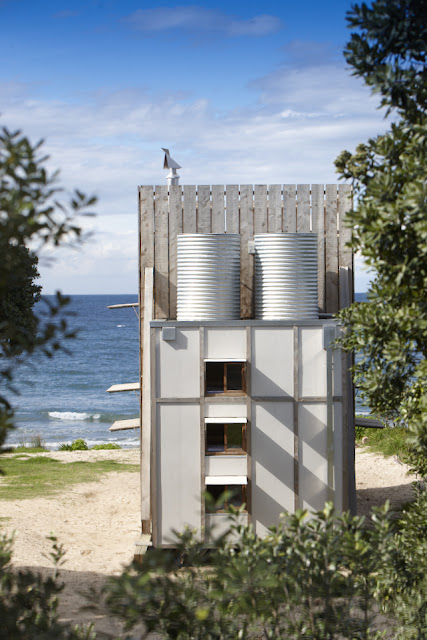In our April/May issue, we introduced you to a tiny house, "Hut on Sleds" on the Coromandel Peninsula at Whangapoua Beach designed by Ken Crosson(below). This diminutive, charming holiday home was a finalist in our Home of the Year award 2012, and subsequently shortlisted in the World Architecture Festival's awards. It is such a cleverly built and elegant bach that we wanted to show you more of Jackie Meiring's terrific photographs of it.
"It had to be a de-mountable house," explains Ken, required by the council because it is located within an erosion zone on the Coromandel coast. Measuring a mere 40 square metres, the house rests on two thick wooden 'sleds' that allows it to be dragged anywhere once uncoupled from power and wastewater and untied from the concrete pads beneath the sleds. It lends an entirely different meaning to the idea of moving house.
"It had to be a de-mountable house," explains Ken, required by the council because it is located within an erosion zone on the Coromandel coast. Measuring a mere 40 square metres, the house rests on two thick wooden 'sleds' that allows it to be dragged anywhere once uncoupled from power and wastewater and untied from the concrete pads beneath the sleds. It lends an entirely different meaning to the idea of moving house.
The bach has been designed to close up against elements: with doors and shutters closed (as in the photo above) it is truly hermetic to rain and wind gusts. But when the sun is shining, the house opens up to let the outside in (below).
Beyond the demands of its setting, the bach had to fit its clients' desires as well. "It was all about examining what was the real essence of a bach versus a beach house," says Ken. "They wanted something small and experiental. It's tiny, so the challenge was to make it as bachy as possible, and not waste any space in doing that."
That's why there's an intentionally enforced proximity imposed on its occupants : a compact front living and kitchen area flows through a rear bunkroom for the owners' three young children, and the main bedroom is up a ladder from the living room, sharing the same view as downstairs through the huge glass doors.

In the main bedroom (above), there are warm shades of macrocarpa joinery and a remarkable attention to storage detail. Downstairs, each of the childrens' beds (below) has their own storage spaces ("secret cubby holes" says Ken), their own lights and windows. The walls themselves double as floor-to-ceiling shelf space that Ken hopes will accumulate the personal histories of the occupants.
The ladder you use to reach the main bedroom also brings you to the roof terrace, which catches rainwater for the gravity tanks behind (below), and affords great views of the beach and the sunsets.
Inside, there are intentional references made by Ken and his clients to the campground, such as the deliberately rudimentary tap and shower fittings. As Ken says: "You know, where you fill your bucket. It's that kind of idea"
To one side, a second entrance to the house via the shower and bathroom, allows occupants to shower straight away after going to the beach (below).
"It's kind of like a tent," says Ken about the bach's structure. "It's dramatic and vertical. The tent flap [the huge macrocarpa front shutter] is that big door that opens up - a big gesture that embraces the view."









Tidak ada komentar:
Posting Komentar